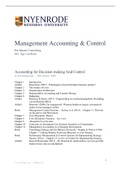Samenvatting
Samenvatting Management Accounting & Control - Nyenrode
- Instelling
- Nyenrode Business Universiteit (Nyenrode)
Deze samenvatting geeft je een overzicht van alle stof die er voor het vak Management Accounting & Control tijdens van de Pre-master Controlling op Nyenrode bestudeerd moet worden. Zo worden de relevante hoofdstukken van het boek Accounting for Decision making And Control van Zimmerman behande...
[Meer zien]




